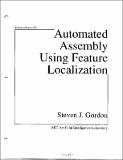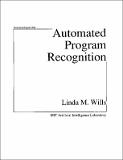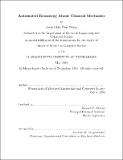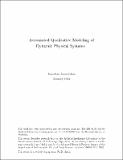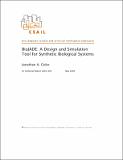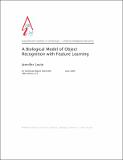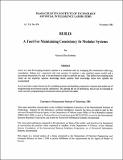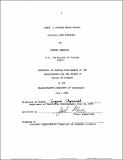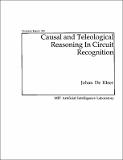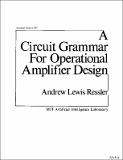Browsing AI Technical Reports (1964 - 2004) by Title
Now showing items 21-40 of 327
-
Automated Assembly Using Feature Localization
(1986-12-01)Automated assembly of mechanical devices is studies by researching methods of operating assembly equipment in a variable manner; that is, systems which may be configured to perform many different assembly operations ... -
Automated Program Recognition
(1987-02-01)The key to understanding a program is recognizing familiar algorithmic fragments and data structures in it. Automating this recognition process will make it easier to perform many tasks which require program understanding, ... -
Automated Program Recognition by Graph Parsing
(1992-07-01)Recognizing standard computational structures (cliches) in a program can help an experienced programmer understand the program. We develop a graph parsing approach to automating program recognition in which programs ... -
Automated Reasoning About Classical Mechanics
(1994-05-01)In recent years, researchers in artificial intelligence have become interested in replicating human physical reasoning talents in computers. One of the most important skills in this area is predicting how physical ... -
Automatic Analysis and Synthesis of Controllers for Dynamical Systems Based On P
(1992-09-01)I present a novel design methodology for the synthesis of automatic controllers, together with a computational environment---the Control Engineer's Workbench---integrating a suite of programs that automatically analyze ... -
Automatic Analysis of the Logical Structure of Programs
(1978-12-01)This report presents a method for viewing complex programs as built up out of simpler ones. The central idea is that typical programs are built up in a small number of stereotyped ways. The method is designed to make ... -
Automatic Qualitative Analysis of Ordinary Differential Equations Using Piecewise Linear Approximations
(1988-03-01)This paper explores automating the qualitative analysis of physical systems. It describes a program, called PLR, that takes parameterized ordinary differential equations as input and produces a qualitative description of ... -
Automatic Qualitative Modeling of Dynamic Physical Systems
(1993-01-01)This report describes MM, a computer program that can model a variety of mechanical and fluid systems. Given a system's structure and qualitative behavior, MM searches for models using an energy-based modeling framework. ... -
Automatically Recovering Geometry and Texture from Large Sets of Calibrated Images
(1999-10-22)Three-dimensional models which contain both geometry and texture have numerous applications such as urban planning, physical simulation, and virtual environments. A major focus of computer vision (and recently graphics) ... -
Basis Reduction Algorithms and Subset Sum Problems
(1991-06-01)This thesis investigates a new approach to lattice basis reduction suggested by M. Seysen. Seysen's algorithm attempts to globally reduce a lattice basis, whereas the Lenstra, Lenstra, Lovasz (LLL) family of reduction ... -
BioJADE: A Design and Simulation Tool for Synthetic Biological Systems
(2004-05-28)The next generations of both biological engineering and computer engineering demand that control be exerted at the molecular level. Creating, characterizing and controlling synthetic biological systems may provide us ... -
A Biological Model of Object Recognition with Feature Learning
(2003-06-01)Previous biological models of object recognition in cortex have been evaluated using idealized scenes and have hard-coded features, such as the HMAX model by Riesenhuber and Poggio [10]. Because HMAX uses the same set ... -
Boundaries and Topological Algorithms
(1988-09-01)This thesis develops a model for the topological structure of situations. In this model, the topological structure of space is altered by the presence or absence of boundaries, such as those at the edges of objects. ... -
BUILD: A Tool for Maintaining Consistency in Modular Systems
(1985-11-01)Build is a tool for keeping modular systems in a consistent state by managing the construction tasks (e.g. compilation, linking, etc.) associated with such systems. It employs a user supplied system model and a ... -
Building Grounded Abstractions for Artificial Intelligence Programming
(2004-06-16)Most Artificial Intelligence (AI) work can be characterized as either ``high-level'' (e.g., logical, symbolic) or ``low-level'' (e.g., connectionist networks, behavior-based robotics). Each approach suffers from particular ... -
CARPS: A Program which Solves Calculus Word Problems
(1968-07-01)A program was written to solve calculus word problems. The program, CARPS (CALculus Rate Problem Solver), is restricted to rate problems. The overall plan of the program is similar to Bobrow's STUDENT, the primary ... -
Causal and Teleological Reasoning in Circuit Recognition
(1979-09-01)This thesis presents a theory of human-like reasoning in the general domain of designed physical systems, and in particular, electronic circuits. One aspect of the theory, causal analysis, describes how the behavior ... -
A Circuit Grammar For Operational Amplifier Design
(1984-01-01)Electrical circuit designers seldom create really new topologies or use old ones in a novel way. Most designs are known combinations of common configurations tailored for the particular problem at hand. In this thesis ... -
Coherent Behavior from Incoherent Knowledge Sources in the Automatic Synthesis of Numerical Computer Programs
(1981-01-01)A fundamental problem in artificial intelligence is obtaining coherent behavior in rule-based problem solving systems. A good quantitative measure of coherence is time behavior; a system that never, in retrospect, ... -
A Colony Architecture for an Artificial Creature
(1989-09-01)This report describes a working autonomous mobile robot whose only goal is to collect and return empty soda cans. It operates in an unmodified office environment occupied by moving people. The robot is controlled by a ...

